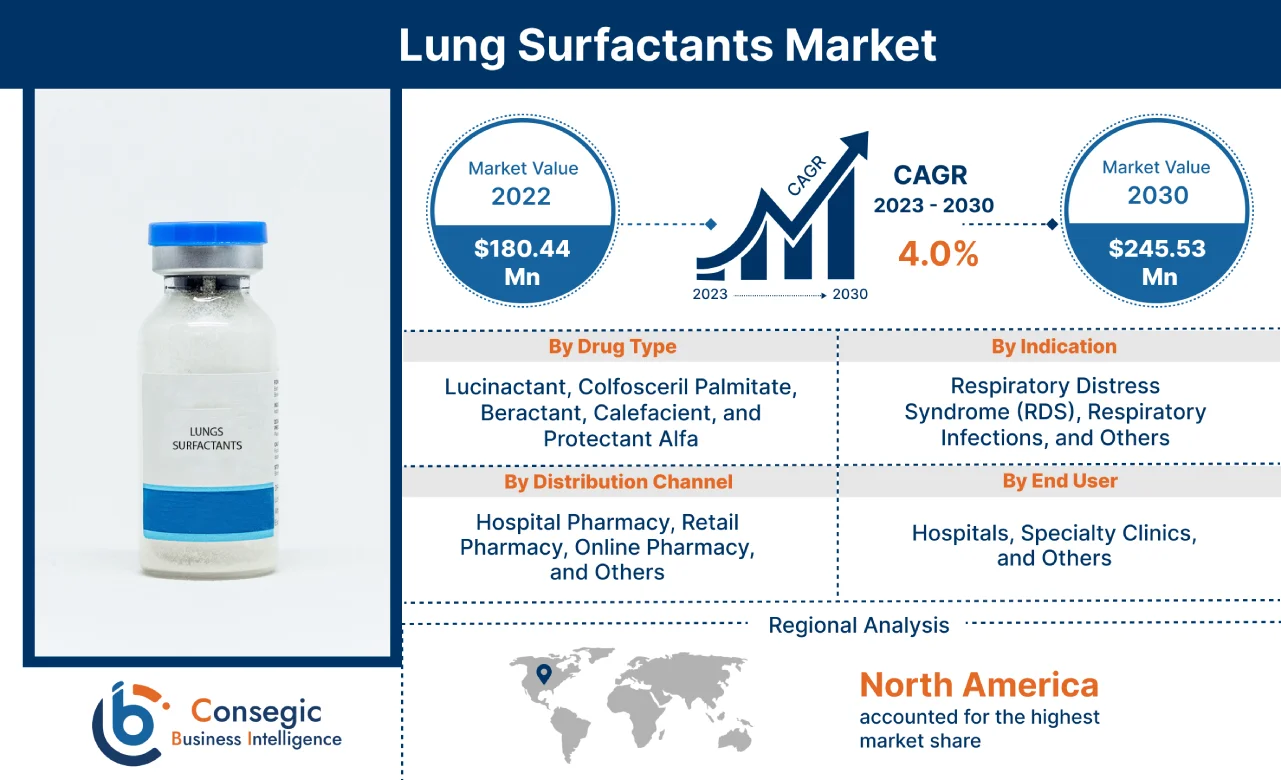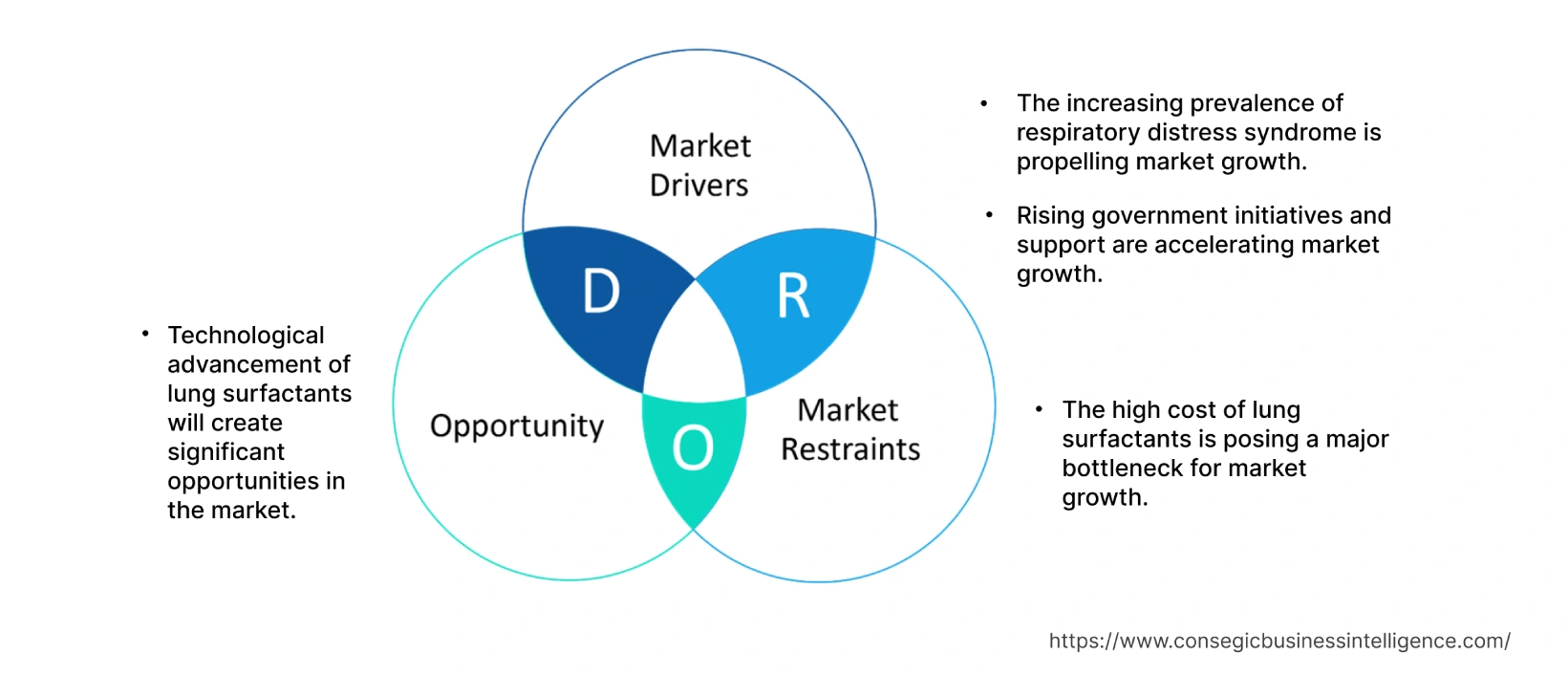Lung Surfactants Market Introduction :
Consegic Business Intelligence analyzes that the lung surfactants market is growing with a healthy CAGR of 4.0% during the forecast period (2023-2030), and the market is projected to be valued at USD 245.53 Million by 2030 from USD 180.44 Million in 2022.
Lung Surfactants Market Definition & Overview:
Lung surfactant is a complex mixture of lipids and proteins that is produced by type II alveolar cells in the lungs. It is essential for breathing because it reduces the surface tension of the air-liquid interface in the alveoli. This prevents the alveoli from collapsing when the lungs exhale. Lung surfactant play a crucial role in maintaining the functions and integrity of the respiratory system. The composition of the lungs surfactants primarily consists of lipids (fatty substances) and proteins. They help to prevent the accumulation of fluids in the lungs, enhance the clearance of debris and pathogens, and contribute to the immune defense of the respiratory system. Further, lung surfactants are used as a therapeutic intervention in the treatment of respiratory distress syndrome (RDS).
Lung Surfactants Market Insights :
Lung Surfactants Market Dynamics - (DRO) :
Key Drivers :
The increasing prevalence of respiratory distress syndrome is propelling market growth
Lung surfactant is a substance that helps keep the lungs' air sacs (alveoli) open and prevents them from sticking together. Respiratory distress syndrome (RDS) is a serious condition that occurs in premature infants when their lungs do not produce enough surfactant. The rising number of respiratory distress syndrome (RDS) globally has led to an increased demand for lung surfactants. Surfactant is a mixture of fat and proteins made in the lungs. Lung surfactant is the standard treatment for RDS, significantly improving the outcomes for preterm infants as it prevents the air sacs of the lungs from collapsing by reducing surface tension.
For instance, in 2021, as per the report of the Centre for Disease Control and Prevention (CDC), The preterm birth rate rose 4% in 2021, from 10.1% in 2020 to 10.5% in the United States. Hence the increasing prevalence of Respiratory Distress Syndrome (RDS) and preterm births become significant driving factors in the lung surfactants market.
Rising government initiatives and support are accelerating market growth
Government initiatives and support play a significant role in driving the growth of the lung surfactant market. Governments around the world have implemented various neonatal health programs to reduce infant mortality rates and improve the overall health of premature infants. These programs often include initiatives to enhance access to essential healthcare interventions. The government may provide funding, subsidies, or reimbursement schemes to ensure that lung surfactant products are accessible and affordable for healthcare facilities and patients. For instance, in 2019, the government of the UK launched The Maternity and Neonatal Safety Improvement Programme (MatNeoSIP). A program aims to improve the safety and outcomes of maternal and neonatal care by reducing unwarranted variation and providing a high-quality healthcare experience for all women, babies, and families across maternity and neonatal care settings in England.
Therefore, it is evident from the above data that the rising government support and spending are propelling the demand for lung surfactants to ensure accurate diagnosis and treat respiratory distress syndrome. This prime factor is boosting the growth of the market.
Key Restraints :
The high cost of lung surfactants is posing a major bottleneck for market growth
Lungs surfactants can be expensive, especially for patients in low and middle-income countries for those without adequate health insurance coverage. The high cost of lung surfactant therapy can limit access to treatment and pose a financial burden on patients and the healthcare system. Affordability concerns may restrict market growth, particularly in regions with limited healthcare resources. Furthermore, the lack of trained healthcare professionals also becomes a barrier to the growth of the lung surfactants market which, in turn, is restraining the overall market growth.
Future Opportunities :
Technological advancement of lung surfactants will create significant opportunities in the market
Ongoing advancements in technology and research present opportunities for innovation in the development of lung surfactants. This includes the improvement of synthetic lung surfactants to better mimic the properties and functions of natural lung surfactants. For instance, in 2019, an article published by the National Institute of Health (NIH), Novel synthetic surfactants containing synthetic phospholipid incorporated with SP-B and SP-C analogs will potentially represent alternatives to natural surfactants in the future.
Further, these advancements offer the potential for improved treatment outcomes and enhance the patient experience. Continued investment in research and development along with collaboration between market players, will create significant opportunity for the lung surfactant market in the forecast year.
Lung Surfactants Market Report Insights :
| Report Attributes | Report Details |
| Study Timeline | 2017-2030 |
| Market Size in 2030 | USD 245.53 Million |
| CAGR (2023-2030) | 4.0% |
| By Drug Type | Lucinactant, Colfosceril Palmitate, Beractant, Calefacient, and Protectant Alfa |
| By Indication | Respiratory Distress Syndrome (RDS), Respiratory Infections, and Others |
| By Distribution Channel | Hospital Pharmacy, Retail Pharmacy, Online Pharmacy, and Others |
| By End User | Hospitals, Specialty Clinics, and Others |
| By Region | North America, Europe, Asia-Pacific, Latin America, and Middle East & Africa |
| Key Players | CHIESI Farmaceutici S.p.A., ONY Biotech Inc, Lyomark Pharma GmbH, Windtree Therapeutics, Inc, Aviva Systems Biology Corporation, Boehringer Ingelheim International GmbH., and Nanjing Norris Pharm Technology, AbbVie Inc. |
Lung Surfactants Market Segmental Analysis :
Based on the Drug Type :
The drug type segment is categorized into lucinactant, colfosceril palmitate, beractant, calefacient, protectant alfa. In 2022, the lucinactant segment accounted for the highest market share in the overall lung surfactants market. Lucinactant is a synthetic lung surfactant that is designed to mimic the properties and functions of natural lung surfactants. It is composed of a mixture of lipids and proteins. Lucinactant is primarily used for the prevention and treatment of respiratory distress syndrome (RDS) in premature infants. For instance, according to the data published by the World Health Organization (WHO), it is estimated that about 13.4 million babies were born preterm in 2020 (before 37 completed weeks of gestation).
However, the Beractant segment is expected to be the fastest-growing segment during the forecast period. Due to its established efficacy and long-standing use in neonatal care. It is a natural lung surfactant derived from minced bovine lings. Furthermore, the increasing preterm birth rate and other factors led to the demand for lucinactant for the treatment of respiratory distress syndrome (RDS) in babies. Which in turn, accelerates the growth of the market.
Based on the Indication :
The indication segment is categorized into respiratory distress syndrome (RDS), respiratory infections, and others. In 2022, the respiratory distress syndrome (RDS) segment accounted for the highest market share in the Lung Surfactants market. RDS occurs in babies born early (premature) whose lungs are not fully developed. The earlier the infant is born, the more likely it is for them to have RDS and need extra oxygen and help breathing. For instance, as per the article published by the National Institute of Health (NIH) in 2019, In the United States, respiratory distress syndrome (RDS) is seen in about 1% of pregnancies and affects 20,000 to 30,000 infants each year. The increased rate of respiratory distress syndrome in premature babies is driving the growth of the segment.
However, the respiratory infection segment is expected to be the fastest-growing segment during the forecast period. The use of lung surfactants is used in respiratory infection to improve lung function and facilitate oxygenation in adults and children. which, in turn, is driving the segment growth. Furthermore, above mentioned factors are increasing the growth of the respiratory distress syndrome segment.
Based on the Distribution Channel :
The distribution channel segment is categorized into hospital pharmacy, retail pharmacy, online pharmacy, and others. In 2022, the hospital pharmacy segment accounted for the highest market share in the lung surfactants market. Hospital pharmacies serve as a primary distribution channel for lung surfactants. They are responsible for procuring and stocking lung surfactant products, ensuring their availability for healthcare professionals and patients within the hospital setting. hospital pharmacy plays a crucial role in the distribution of lung surfactant market. As they directly supply the product to the Neonatal Care Units ( NCUs) in the hospital ensuring to timely availability of the drugs.
However, the retail pharmacy segment is expected to be the fastest-growing segment during the forecast period. The retail pharmacy is more common in regions where lung surfactants are available for home use or administration by healthcare professionals outside of hospital settings. Hence, above mentioned factors are driving the growth of the market.
Based on the End-User :
The end user segment is categorized into hospitals, specialty clinics, and others. In 2022, the hospital segment accounted for the highest market share of 45.50% in the lung surfactants market. Hospitals, including neonatal intensive care units (NICUs), are the primary end user of lung surfactant products. These facilities have the infrastructure, equipment, and specialized healthcare professionals to administer lung surfactant therapy to premature infants with respiratory distress syndrome (RDS). Hospitals typically procure the drugs from manufacturers or through authorized distributors. For instance, according to the report of the National Organization Of Rare Disorders, hospital mortality for Acute respiratory distress syndrome (ARDS) is about 40-50%. Thus the increasing mortality rate for respiratory distress syndrome (RDS) is driving the growth of the segment.
However, the specialty clinics segment is expected to be the fastest-growing segment during the forecast period. This is because of well-established specialty clinics in countries such as the U.S. and China. Furthermore, the above mentioned factors will drive the growth of the lung surfactant in the market.
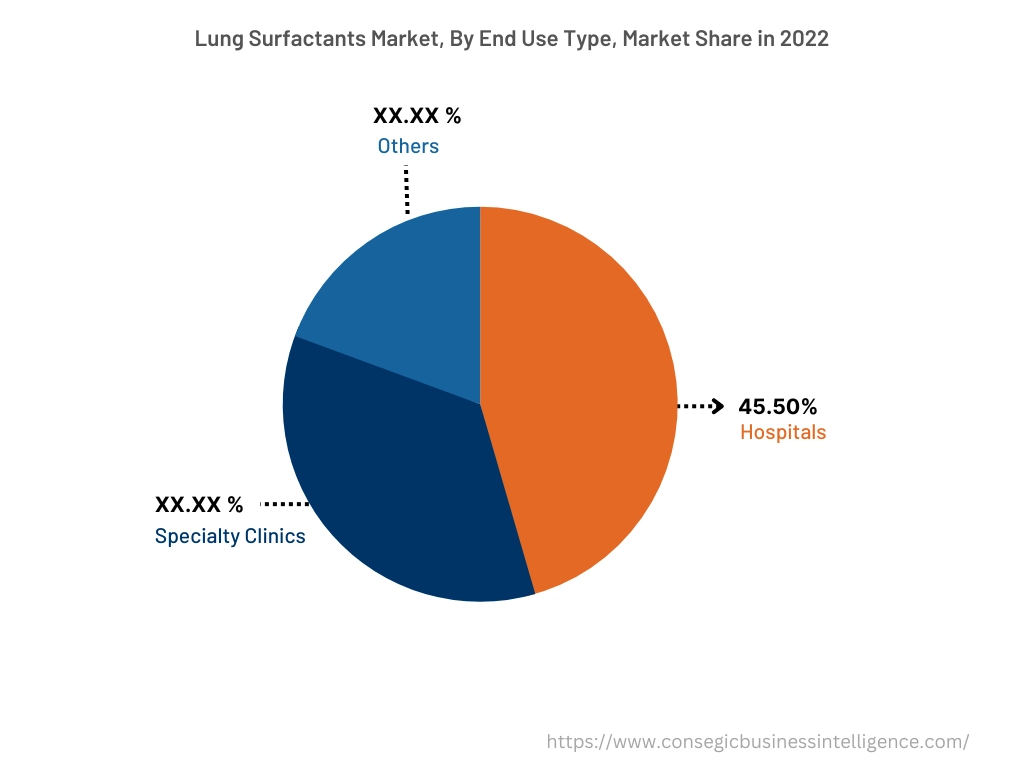
Based on the Region :
The regional segment includes North America, Europe, Asia Pacific, Middle East and Africa, and Latin America.
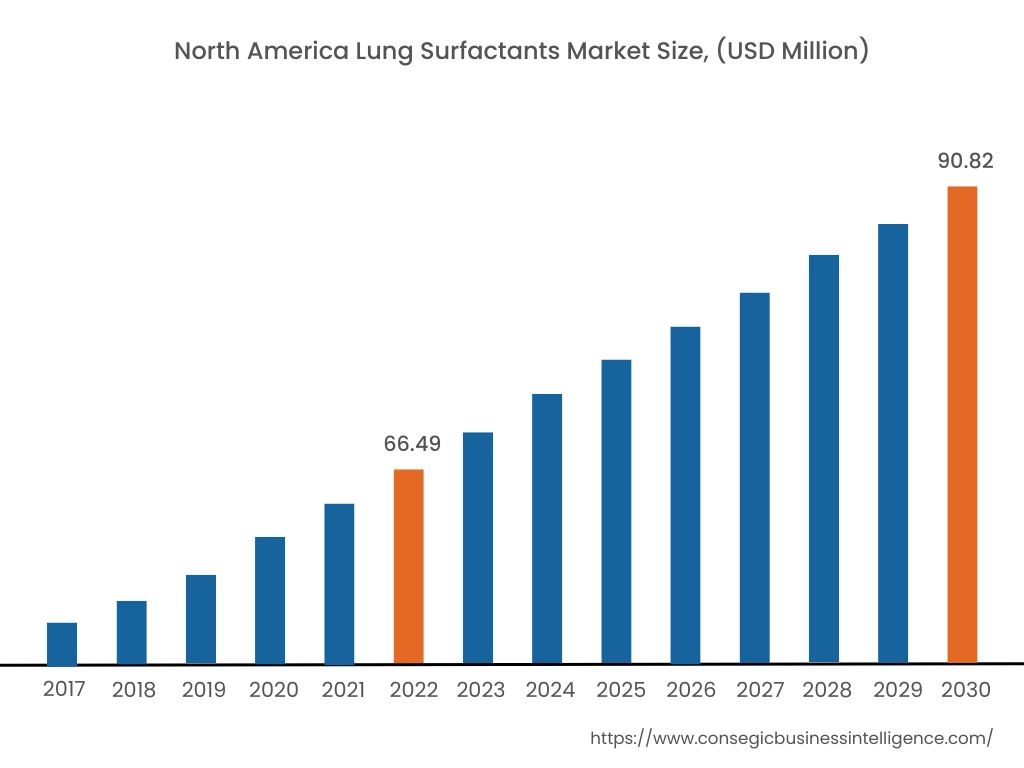
In 2022, North America accounted for the highest market share at 36.85% and was valued at USD 66.49 million, and is expected to reach USD 90.82 million in 2030. In North America, the U.S. accounted for the highest market share of 68.20% during the base year of 2022. This is due to the advanced healthcare infrastructure, high prevalence of premature births, and well-established neonatal care units in the regions. For instance, in 2021, as per the data published by Yale Medicine Organization, about 190,000 Americans were diagnosed with Acute Respiratory Distress Syndrome (ARDS) each year in the U.S.
Furthermore, Asia Pacific is expected to witness significant growth over the forecast period, growing at a CAGR of 4.8% during 2023-20230. This is attributed to the increasing awareness of lung surfactant therapy and rising healthcare expenditure in the Asia Pacific. Hence, above mentioned factors are driving the market growth in the region.
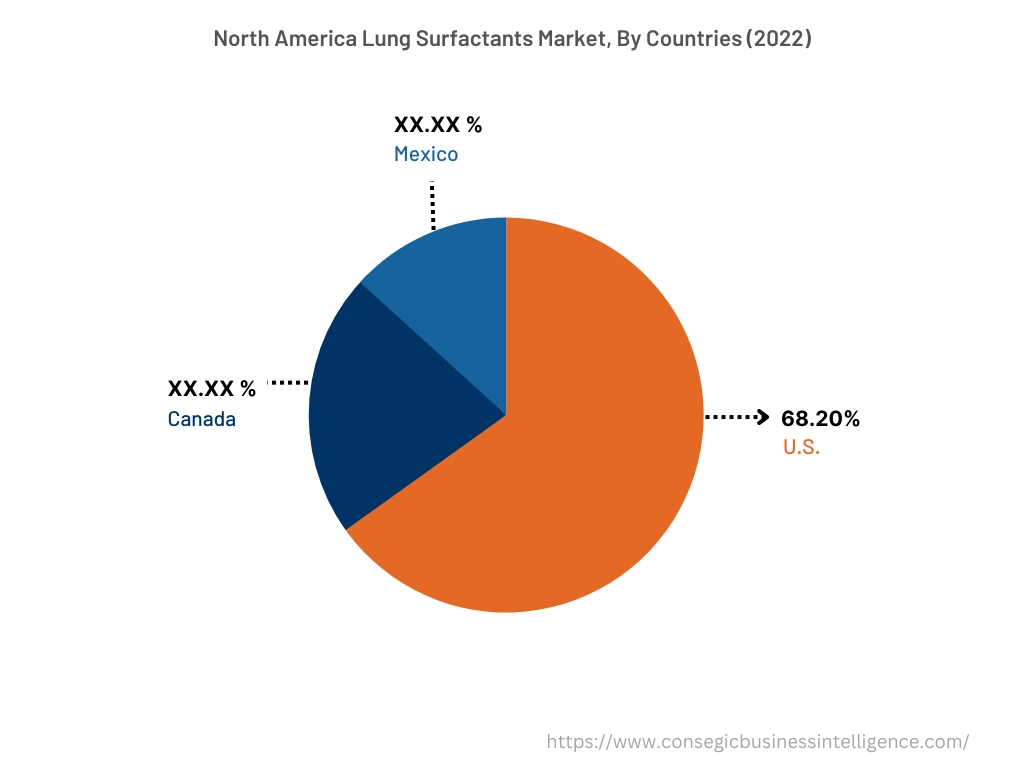
Top Key Players & Market Share Insights:
The lung surfactants market is highly competitive, with several large players and numerous small and medium-sized enterprises. These companies have strong research and development capabilities and a strong presence in the market through their extensive product portfolios and distribution networks. The market is characterized by intense competition, with companies focusing on expanding their product offerings and increasing their market share through mergers, acquisitions, and partnerships. The key players in the market include-
- ONY Biotech Inc
- Lyomark Pharma GmbH
- Nanjing Norris Pharm Technology
- CHIESI Farmaceutici S.p.A.
- AbbVie Inc.
- Windtree Therapeutics, Inc
- Aviva Systems Biology Corporation
- Boehringer Ingelheim International GmbH.
Recent Industry Developments :
- In May 2020, JK Lon Hospital introduced the less invasive surfactant administration (LISA) technique at its neonatal intensive care unit (NICU) for the treatment of premature lung disease in newborns.
- In August 2022, Windtree Therapeutics announced a global licensing agreement with Lee's Pharmaceutical (HK) Limited, (Lee's) and its affiliate Zhaoke Pharmaceutical (Hefei) Co. Ltd., (Zhaoke). The agreement will focus on the development and commercialization of Windtree's acute pulmonary pipeline treatments KL4 surfactant and drug/device combination, AEROSURF, for the treatment of preterm infants with respiratory distress syndrome (RDS) and other potential applications.
Key Questions Answered in the Report
What was the market size of the lung surfactants industry in 2022? +
In 2022, the market size of lung surfactants was USD 180.44 million
What will be the potential market valuation for the lung surfactants industry by 2030? +
In 2030, the market size of lung surfactants will be expected to reach USD 245.53 million.
What are the key factors driving the growth of the lung surfactants market? +
The increasing prevalence of respiratory distress syndrome is driving the global lung surfactants market growth.
What is the dominating segment in the lung surfactants market by the end user? +
In 2022, the hospital segment accounted for the highest market share of 45.50% in the overall lung surfactants market.
Based on current market trends and future predictions, which geographical region is the dominating region in the lung surfactants market? +
North America accounted for the highest market share in the overall lung surfactants market.
